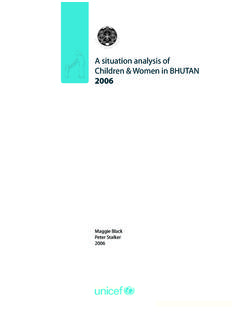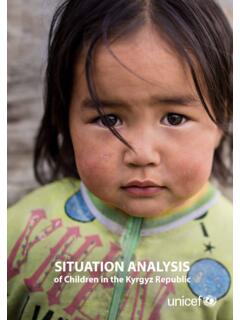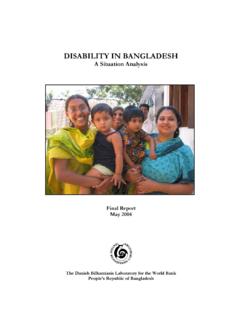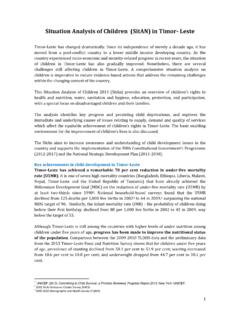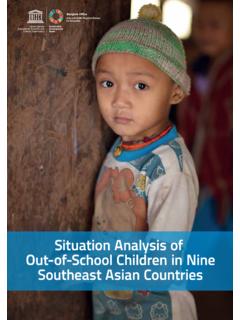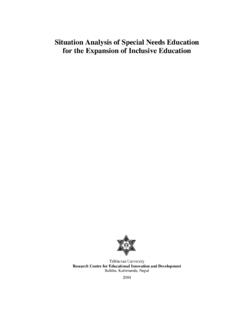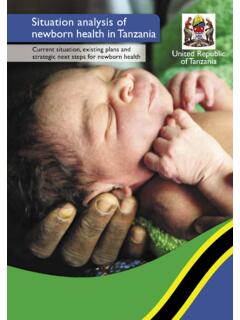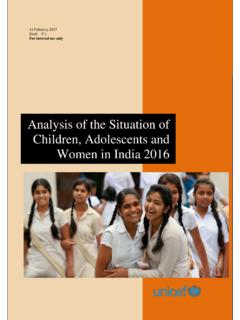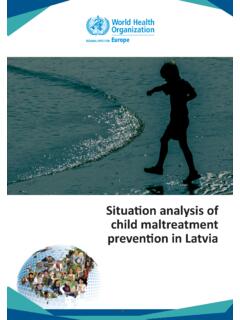Transcription of SITUATION ANALYSIS OF CHILDREN AND WOMEN IN THE …
1 SITUATION ANALYSIS OF CHILDREN AND WOMEN IN THE DEMOCRATIC PEOPLE S REPUBLIC OF KOREA 2017 Report prepared byThe Bassiouni GroupChristopher DavidsSylvie Morel-SeytouxLaura WicksDavid Solomon Bassiouni United Nations CHILDREN s Fund (UNICEF)2016 Printed in Pyongyang, DPR KoreaThe opinions expressed are those of the authors and do not necessarily reflect the opinions of the UnitedNations CHILDREN s Nations CHILDREN s Fund28 MunsudongPyongyang, DPRKTel: +442070849759 Fax:+4423817949E-mail: photo: UNICEF DPRK/2016 Design by In s Communication ANALYSIS OF CHILDREN AND WOMEN IN THE DEMOCRATIC PEOPLE S REPUBLIC OF KOREA 2017 CONTENTSA cronyms ivAcknowledgements and Contributions viExecutive Summary 1 Key Findings 2 Summary of the Way Forward for UNICEF and Partners 4 Chapter One Introduction 8 Introduction 8 Background 8 Objectives of the
2 SITUATION ANALYSIS 9 Process 9 Methodology and Conceptual Approach 10 Conceptual Framework 11 Chapter Two National Context for CHILDREN and WOMEN s Rights 14 Introduction 14 Demographic Context 14 Urbanization 15 Socio-economic Context 15 Housing Characteristics and Amenities 17 People with Disabilities 19 Climate and Disaster Risks 20 National Legislative Environment and Mechanisms for Monitoring, Reporting, and Evaluation 22 Gender Equality and WOMEN s Empowerment 25 Chapter Three The Right to Survive and Thrive 30 Introduction 30 Assessment of Survival Status 31 Maternal Mortality 34 Illness and Diseases Affecting CHILDREN in DPR Korea 37 Nutrition 40 Water, Sanitation, and Hygiene (WASH)
3 45 Key Determinants ANALYSIS Bottlenecks and Barriers 48 Key Data Gaps 54 The Way Forward 55 Chapter Four Education and Adolescence 58 Assessment of the State of Education in DPR Korea 59 Education for CHILDREN with Disabilities 63 Gender Considerations in Education 64 Educational Quality 65 Outcomes 66 Adolescence 67 Key Data Gaps 69 The Way Forward 69 Chapter Five Conclusions and Implications for Action 72 Implications for Action 73 Annex One References 75 Annex Two Key Informants Interviewed (Alphabetical)
4 79 Annex Three Methodological Framework 80 Annex Four Summary of Key Data Gaps 82 Annex Five Status of SDG Child-Relevant Indicators in DPR Korea 83 LIST OF TABLEST able 1: Percentage of Dwellings by Household Conditions and Amenities according to Place of Residence 18 Table 2: Key Legislation in Support of WOMEN s and CHILDREN s Rights in DPR Korea 24 Table 3: Per Capita ODA among Selected Countries of East Asia and the Pacific Region (US$) 26 Table 4: Infant Mortality Rate by Sex and Location, 1993 and 2008 33 Table 5: Comparative Outcomes and Performance-Reduction in U5MR in East Asia and the Pacific (1990 2015) 34 Table 6: Delay Factors Urban/Rural (%) 36 Table 7: Comparative Outcomes and Performance-Reduction in MMR in East Asia and the Pacific (1990 2015) 37 Table 8: Incidence Rate of Diarrheal Disease and Respiratory Illness 38 Table 9: Notified New and Relapse Cases of TB per 100,000 by Age and Sex in DPRK, 2014 39 Table 10.
5 Comparative Outcomes and Performance in Nutrition East Asia and the Pacific (1990 2015) 43 Table 11: Health Facilities in DPR Korea 50 Table 12: Percent Distribution of School Attendance of Persons 5 to 24 Years by Location and Gender 59 Table 13: Key Early Childhood Development (ECD) Indicators 60 Table 14: DPR Korea Enrolment Data 2008 and 2012 62 Table 15: Number of Schools, Students, and Teachers in DPR Korea 62 LIST OF FIGURESF igure 1: Conceptual Framework for the SITUATION ANALYSIS in DPRK 11 Figure 2: Infant, Child, and Maternal Mortality Survival Diagram 30 Figure 3: Global Estimates of Under-Five, Infant, and Neonatal Mortality Rates in DPRK 1990 2015 32 Figure 4: Infant, Child, and Maternal Mortality Survival Diagram 33 Figure 5: DPRK Maternal Mortality Ratio 35 Figure 6: Trends in malaria cases and incidence, DPR Korea (2009 2015) 38 Figure 7.
6 Trends in key Tuberculosis indicators, DPR Korea 39 Figure 8: Trend ANALYSIS of Nutrition Indicators in DPRK 2000 2012 (%) 41 Figure 9: Advanced Educational Attainment of DPRK Population 5+ Years 63 Figure 10: Tertiary Educational Attainment of DPRK Population 5+ Years 64 Figure 11: Key Determinants Framework for SITUATION ANALYSIS 81 AcronymsARIA cute Respiratory InfectionARRA nnual Rate of ReductionC4 DCommunications for DevelopmentCAConservative AgricultureCEDAWC onvention on the Elimination of all forms of Discrimination Against WomenCERFC entral Emergency Response FundCFSC hild-Friendly SchoolsCMAMC ommunity Management of Acute MalnutritionCRCC onvention on the Rights of the ChildCRPDC onvention on the Rights of Persons with DisabilitiesCBSC entral Bureau of StatisticsDEWATSD ecentralized Wastewater Treatment SystemsDHSD emographic Health SurveyDPRD emocratic People s RepublicDPRK Democratic People s Republic of KoreaECEducation CommissionECDE arly
7 Childhood DevelopmentECDIE arly Childhood Development IndexECEE arly Childhood EducationE FAEducation For AllEmONCE mergency Obstetric and Neonatal CareFAOU nited Nations Food and Agriculture OrganizationGAVIG lobal Alliance for Vaccines and ImmunizationGFATMG lobal Fund to Fight AIDS, TB, and MalariaGFSG ravity-Fed Water SystemsGPSHG rand People s Study HouseIASCI nter-Agency Standing CommitteeICCPRI nternational Covenant on Civil and Political RightsICESCRI nternational Covenant on Economic, Social, and Cultural RightsIDDI odine Deficiency DisorderI FAIron, Folate, and Vitamin AIFRCI nternational Federation of Red Cross and Red Crescent SocietiesIGCMEU nited Nations Interagency Group for Child Mortality EliminationIMNCII ntegrated Management of Newborn and Childhood IllnessesIMRI nfant Mortality RateIUDI ntrauterine DeviceIYCFI nfant and Young Child FeedingKFPDK orean Federation for the Protection of the DisabledLBWLow Birth WeightMDGsMillennium Development GoalsMDRM ulti-Drug ResistantMICSM ultiple Indicator Cluster SurveyivSITUATION ANALYSIS OF CHILDREN AND WOMEN IN THE DEMOCRATIC PEOPLE S REPUBLIC OF KOREA 2017 AcronymsMMRM aternal Mortality RateMNPM ulti-Micronutrient PowderMNTM ulti-Micronutrient TabletsMoCMMinistry of City ManagementMoPHMinistry of Public HealthMoUMemorandum of
8 UnderstandingMPPTMass Primaquine Preventative TreatmentMTSP 1 Medium Term Strategic PlanMUACMid-Upper Arm CircumferenceNCCN ational Coordinating CommitteeNNMRN eonatal Mortality RateOCHAO ffice for the Coordinator of Humanitarian AffairsODAO fficial Development AssistancePDSP ublic Distribution SystemPISAP rogramme for International Student AssessmentPSPAP residium of the Supreme People s AssemblyRHSR eproductive Health SurveySAMS evere Acute MalnutritionSCEDMS tate Committee for Emergency and Disaster ManagementSDGsSustainable Development GoalsSDHSS ocio-Demographic Health SurveySit-AnSituation AnalysisTBTuberculosisTGRT otal Goiter RateU5 MRUnder-Five Mortality RateUNUnited NationsUNCRPDU nited Nations Convention of the Rights of People with DisabilitiesUNCTU nited Nations Country TeamUNDPU nited Nations Development ProgrammeUNESCOU nited Nations Educational, Scientific and Cultural OrganizationUNFPAU nited Nations Population FundUNHRCU nited Nations Human Rights CouncilWASHW ater, Sanitation, and HygieneWFPW orld Food ProgrammeWHOW orld Health OrganizationvAcronymsAcknowledgements and ContributionsThe SITUATION ANALYSIS of CHILDREN and WOMEN in the Democratic People s Republic of Korea (Sit-An)
9 2017 has been jointly produced by the UNICEF Country Office in DPR Korea, in close collaboration with various government ministries and departments of DPR Korea Under the overall direction of Ms Oyunsahain Dendevronov, UNICEF Country Representative for DPR Korea, the Sit-An was developed through a participatory and collaborative process under the guidance of Mr Murat Sahin, UNICEF Deputy Representative, Mr Shailesh Kumar Nayak, UNICEF M&E Specialist for DPR Korea, and Ms Stephanie Kleschnitzki, UNICEF EAPRO The study was carried out by The Bassiouni Group (TBG), a global development firm based in New York, comprised of senior international development professionals, including Mr Christopher Davids (Team Leader), Ms Sylvie Morel-Seytoux, Ms Laura Wicks, and
